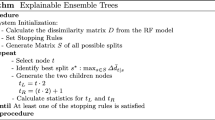Abstract
This paper introduces a new method for explaining the predictions of ensembles of neural networks on a case by case basis. The approach of explaining individual examples differs from much of the current research which focuses on producing a global model of the phenomenon under investigation. Explaining individual results is accomplished by modelling each of the networks as a rule-set and computing the resulting coverage statistics for each rule given the data used to train the network. This coverage information is then used to choose the rule or rules that best describe the example under investigation. This approach is based on the premise that ensembles perform an implicit problem space decomposition with ensemble members specialising in different regions of the problem space. Thus explaining an ensemble involves explaining the ensemble members that best fit the example.
Chapter PDF
Similar content being viewed by others
Keywords
These keywords were added by machine and not by the authors. This process is experimental and the keywords may be updated as the learning algorithm improves.
References
Andrews, R., Diederich, J. & Tickle A. (1995) A Survey and Critique of Techniques For Extracting Rules From Trained Artificial Neural Networks, Knowledge Based Systems 8, pp373–389.
Blake, C. L. & Merz, C. J. (1998). UCI Repository of machine learning databases [http://www.ics.uci.edu/ mlearn/MLRepository.html]. Irvine, CA: University of California, Department of Information and Computer Science.
Breiman, L., (1996) Bagging predictors, Machine Learning, 24:123–140.
Cloete, I., & Zurada J. M., (2000) Knowledge Based Neurocomputing(MIT Press, Cambridge, Massachusettes).
Craven, M., & Shavlik, J., (1999) Rule Extraction: Where Do We Go from Here?, University of Wisconsin Machine Learning Research Group Working Paper, 99-1.
Cunningham, P., Carney, J., Jacob, S., (2000) Stability Problems with Artificial Neural Networks and the Ensemble Solution, AI in Medicine, pp217–225, Vol. 20,No. 3.
Das G., Lin K., Mannila H., Renganathan G., Smyth P., (1998) Rule Discovery from Time Series, Proceedings of the Fourth International Conference on Knowledge Discovery and Data Mining, (AAAI Press).
Domingos P., (1998) Knowledge Discovery via Multiple Models, Intelligent Data Analysis, 2, 187–202.
Hanson, L. K., Salomon, P., (1990) Neural Network Ensembles, IEEE Pattern Analysis and Machine Intelligence, 1990. 12,10, 993–1001.
Quinlan, J. Ross., (1988) C4.5 Programs for Machine Learning(Morgan Kaufmann Publishers Inc., San Mateo, CA).
Shortliffe, E. H., (1976) Computer-Based Medical Consultations: MYCIN, New York, Elsevier.
Sima, J., (1995) Neural Expert Systems, Neural Networks 8(2) pp261–271.
Wall, R., Cunningham, P., (2000) Exploring the Potential for Rule Extraction from Ensembles of Neural Networks, 11th Irish Conference on Artificial Intelligence & Cognitive Science (AICS 2000), J. Griffith & C. O'Riordan (eds.) pp52–68 (also available as Trinity College Dublin Computer Science Technical Report TCD-CS-2000-24).
Zenobi G., & Cunningham P., (2001), Using Diversity in Preparing Ensembles of Classifiers Based on Different Feature Subsets to Minimize Generalisation Error, 12th European Conference in Machine Learning (ECML 2001), eds L. De Raedt & P. Flach, LNAI 2167, pp576–587, Springer Verlag.
Author information
Authors and Affiliations
Editor information
Editors and Affiliations
Rights and permissions
Copyright information
© 2002 Springer-Verlag Berlin Heidelberg
About this paper
Cite this paper
Wall, R., Cunningham, P., Walsh, P. (2002). Explaining Predictions from a Neural Network Ensemble One at a Time. In: Elomaa, T., Mannila, H., Toivonen, H. (eds) Principles of Data Mining and Knowledge Discovery. PKDD 2002. Lecture Notes in Computer Science, vol 2431. Springer, Berlin, Heidelberg. https://doi.org/10.1007/3-540-45681-3_37
Download citation
DOI: https://doi.org/10.1007/3-540-45681-3_37
Published:
Publisher Name: Springer, Berlin, Heidelberg
Print ISBN: 978-3-540-44037-6
Online ISBN: 978-3-540-45681-0
eBook Packages: Springer Book Archive




